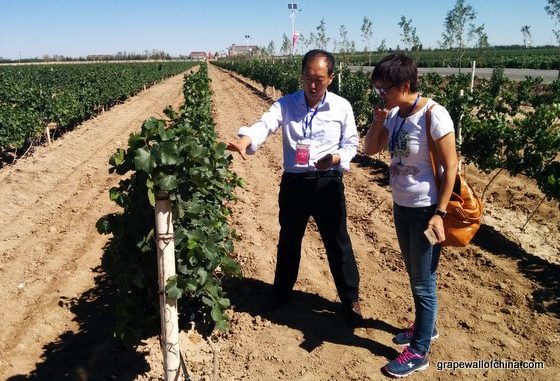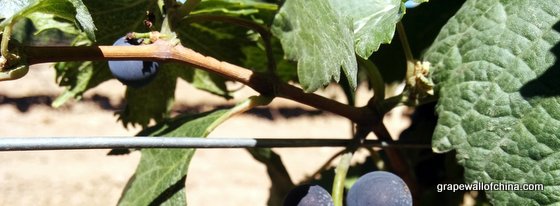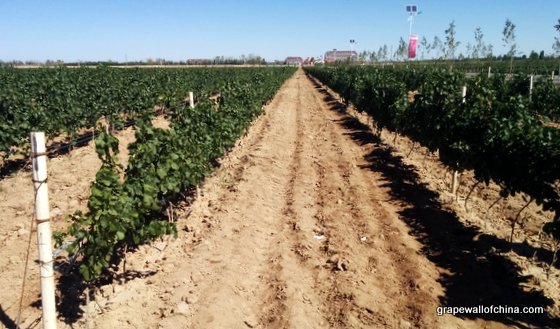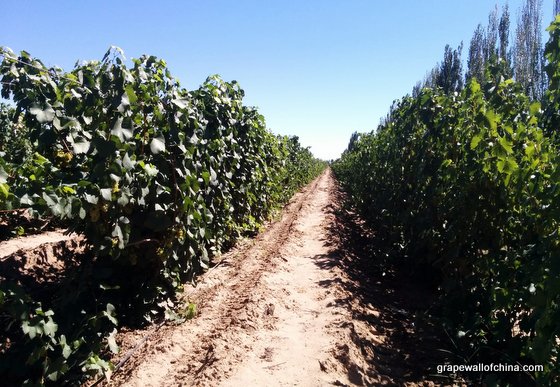
By Jim Boyce | “The older farmers are used to flooding the fields, there is a psychological benefit to seeing the water,” says Wang Runping of Mogao as we tour the company’s Gansu vineyards in northwest China. Wang is explaining “old habits die hard” resistance to efficient drip irrigation, one of many challenges he faces while boosting wine quality, a situation reduced to numbers: he says Mogao currently gets 30 percent of grape potential from older vineyards and 60 percent from newer ones. His goal is to inch much closer to 100 percent before he retires.
Mogao has produced grapes near the city of Wuwei since 1983 and now has 1300 hectares, with Pinot Noir the favored grape. Wang joined the company in 1991 and focused on poppies—Mogao has a wide range of products, including opium—before shifting to grapes in 1998.
We start with the newest vineyard, some four years old and equipped with drip irrigation that allows for a good balance between vegetation and fruit growth.
Grapes are tasted and squeezed, leaves rubbed between fingers, and inter-nodes measured as Wang and Ma Huiqin, a China Agricultural University professor and a regular in the country’s wine operations, survey the vineyard.
“Very healthy,” says Ma.

Wang is very much into those inter-nodes, the gaps between where the leaves sprout on vine stems. With drip irrigation, growth is restrained and both leaves and inter-nodes are smaller—the ones above are about the length of an elongated grape.
The older vineyard we visit feels like a jungle in contrast, with vegetation gone wild.
“See, they’re twice as big,” says Wang, grasping leaves in his hand and talking about farmers and flooding.
Even worse, the vines he is checking are older but the resulting wines tend to be much greener—too green.
“We’re only getting 30 percent of potential,” says Wang. “Thirty percent.”
Irrigation systems aren’t the only key differences between these vineyards.

The rows between vines at the new site are 3.3 meters wide and optimized for mechanization, a necessary move given increasingly scarce and pricey labor. Vines here can be pruned, weeded and buried (winters are deadly cold) to offset the labor challenges far easier than in older vineyards. Wang says Mogao now hires a single farmer here to look after every 200 mu / 13 hectares of vineyard and supplements them with seasonal workers.

Then there is the soil, a history lesson in Mogao’s evolution as a producer. Many old vineyards are on sandy soil and were planted in an era when wine quality was less important than utilizing terrain, particularly that reclaimed from the desert. In stark contrast, the new vineyard is on former corn fields: the use of already productive land for grapes underscores the rise of the Chinese consumer and, in turn, the stress on making better wine and its potential as a value-added product.
There are lots of other differences between old and new vineyards—for example, the new rows run north to south, rather east to west, for more sun exposure—that underscore this move toward quality, one that neighboring region Ningxia has embraced. It hopefully means that percentage point by percentage point, Wang will get to his perfect hundred.
Sign up below for my China wine e-newsletter. Check out sibling sites World Baijiu Day and Beijing Boyce. And see here for ways to support Grape Wall.
Grape Wall has no sponsors of advertisers: if you find the content and projects like World Marselan Day worthwhile, please help cover the costs via PayPal, WeChat or Alipay.
Sign up for the free Grape Wall newsletter here. Follow Grape Wall on LinkedIn, Instagram, Facebook and Twitter. And contact Grape Wall via grapewallofchina (at) gmail.com.

Leave a Reply
You must be logged in to post a comment.